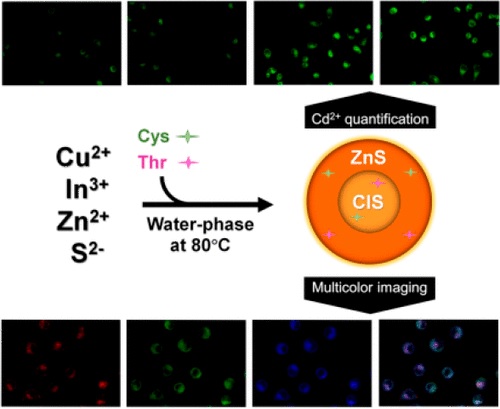王兆寅副教授、戴志晖教授课题组在ANALYTICAL CHEMISTRY发表研究论文
Amino Acid-Capped Water-Soluble Near-Infrared Region CuInS2/ZnS Quantum Dots for Selective Cadmium Ion Determination and Multicolor Cell Imaging
Liu, J (Liu, Jia)[ 1,2 ] ; Zhao, XY (Zhao, Xinyu)[ 1,2 ] ; Xu, HY (Xu, Hanyu)[ 1,2 ] ; Wang, ZY (Wang, Zhaoyin)[ 1,2 ]*(王兆寅); Dai, ZH (Dai, Zhihui)[ 1,2,3 ]*(戴志晖)
[ 1 ] Nanjing Normal Univ, Sch Chem & Mat Sci, Jiangsu Collaborat Innovat Ctr Biomed Funct Mat, Nanjing 210023, Jiangsu, Peoples R China
[ 2 ] Nanjing Normal Univ, Sch Chem & Mat Sci, Jiangsu Key Lab Biofunct Mat, Nanjing 210023, Jiangsu, Peoples R China
[ 3 ] Nanjing Normal Univ, Ctr Anal & Testing, Nanjing 210023, Jiangsu, Peoples R China
ANALYTICAL CHEMISTRY,2010907,91(14),8987-8993
Although attractive for their low toxicity, CuInS2/ZnS core/shell quantum dots (CIS/ZnS QDs) still suffer from poor luminescence efficiency and poor water solubility. Herein, two amino acids (AAs), i.e., cysteine (Cys) and threonine (Thr), are used to tune the properties of CIS/ZnS QDs by capping them in both core and shell. It is found that Thr can regulate the density of Cys on the surface of QDs, thus causing a synergistic effect on the enhancement of photoluminescence (PL) intensity. Capping in the shell mainly leads to the enhancement of PL intensity, and capping in the core results in a red-shift of PL wavelength. Accordingly, a new kind of near-infrared region CIS/ZnS QDs with improved optical properties has been prepared. In addition, the Cys- and Thr-capped CIS/ZnS QDs possess outstanding water solubility and biocompatibility. In this work, the QDs are further employed in Cd2+ determination and multicolor imaging, indicating their potential applications. Relying on the enhancement of PL intensity via cation exchange, the Cys- and Thr-capped CIS/ZnS QDs can sense Cd2+ sensitively. Notably, because ZnS shells of the QDs will not be affected by Zn2+, the analytical method can discriminate Cd2+ from Zn2+ depending on the inherent characteristics of QDs. Moreover, intercellular Cd2+ can also be evaluated by the bright PL from the QDs, and the QDs can achieve multicolor imaging. Overall, this work demonstrates that various properties of QDs may be tuned by capping with AAs, and AA-capped QDs are of great value in advanced biosensing and bioimaging.

文章链接:
https://pubs.acs.org/doi/10.1021/acs.analchem.9b01183
版权与免责声明:本网页的内容由收集互联网上公开发布的信息整理获得。目的在于传递信息及分享,并不意味着赞同其观点或证实其真实性,也不构成其他建议。仅提供交流平台,不为其版权负责。如涉及侵权,请联系我们及时修改或删除。邮箱:sales@allpeptide.com